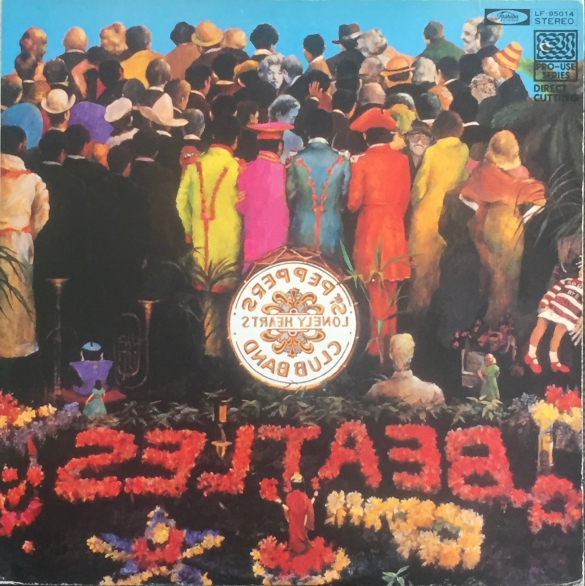The 50th anniversary of the release of “Sgt. Pepper’s Lonely Hearts Club Band” has caused considerable interest in various aspects of what came to be called “the summer of love”; 1967’s glorious pop year. It was also the time of “Swinging London” and Carnaby Street’s first heyday.
That the cover of the “Sgt. Pepper” album would become a classic had been foreseen by Beatles manager Brian Epstein who wanted a “proper” artist to design the cover rather than the original psychedelic ideas suggested by fashion designers The Fool. From an idea by Paul McCartney via his friend and gallery owner Robert Fraser, Peter Blake and Jann Haworth were recruited and with some input from Jann’s father, Ted, the couple set to work.
It didn’t take long for the first of many pastiches of the cover art to appear. The Mothers of Invention’s album “We’re Only in It for the Money” released in March 1968, was one of the earliest. Frank Zappa wanted the cover (designed by Cal Schenkel) to be a copy of the “Sgt. Pepper” cover and asked Paul McCartney for approval. Apparently McCartney wished that Zappa’s and The Beatles’ mangers discussed the suggestion. Zappa went ahead but Verve Records, who would release the album, would not allow Schenkel’s copy of the “Sgt. Pepper” montage to appear on the front so the band’s portrait, photographed against a yellow background became the outside of the gatefold.
The lyrics, printed against a similar red background to those on the “Sgt. Pepper” cover appeared on the inside of the gatefold opposite Schenkel’s montage.
Release of “We’re Only in It for the Money” was delayed five months because of the record company’s anxiety over a possible infringement of copyright. In the event there was no reaction as the front cover only revealed four band members.
There have been innumerable pastiches of the “Sgt. Pepper” cover since the Mothers of Invention’s album; ranging from albums by the Muppets and Simpsons to more “serious” artist like The Ruttles. An Internet search turns up literally hundreds. Probably only the cover photo from The Beatles’ “Abbey Road” has been copied/parodied more often.
My collection includes only three pastiches of the (probably) hundreds out there, collected because of their originality (and possibly rarity). The oldest, from 1969, is Jack O’Reilly’s “You Can Be a Ventriloquist” (subtitled “Constable O’Rourke’s Wooden Hearts Club Band“, just so that no one would miss the reference to “Sgt. Pepper“). An instructional album that was probably privately pressed and thus in relatively limited numbers. O’Reilly went to inordinate expense to put together a background of forty ventriloquists’ dummies for the cover photograph.

The second example is a Japanese album by Jun Fukamachi called (not so strangely) “Sgt. Pepper’s Lonely Hearts Club Band“. Fukamachi plays several of the “Sgt. Pepper” songs rendered as jazz tunes. I like the cover for the idea of reversing the whole scene. It must have taken weeks to paint!

And the final parody that I have collected is another Japanese release–Junichi Masuda’s “Pokèmon” LP from 2015. This is an unoffical release on the Moonshake record label. Masuda, who is programmer and director at Pokèmon also makes the music to video games. The “Pokèmon” album was released in several versions. The “standard” album came in four variations of coloured vinyl housed in a cover that is a parody of the “Sgt. Pepper” design.

Oh, and I have been guilty of plagiarism, too. In 2009 I curated an exhibition of Peter Blake’s record cover art at Piteå Museum. Together with my friends at In the Cold bureau we designed a cover for the exhibition catalogue, of course modelling it on the “Sgt. Pepper” design, but with all the artists that Blake had made record covers for.

In 2010, I showed my collection of Peter Blake’s record covers at the A and D Gallery in London, and Sir Peter Blake signed m catalogue. I wonder if it didn’t inspire him to produce his 2012 update of the Sgt. Pepper cover…

I don’t have this print, though it would make a nice addition to my collection of Sir Peter Blake’s record cover art.
Anyway, I really hope I won’t be tempted to buy any more “Sgt. Pepper” pastiches.







